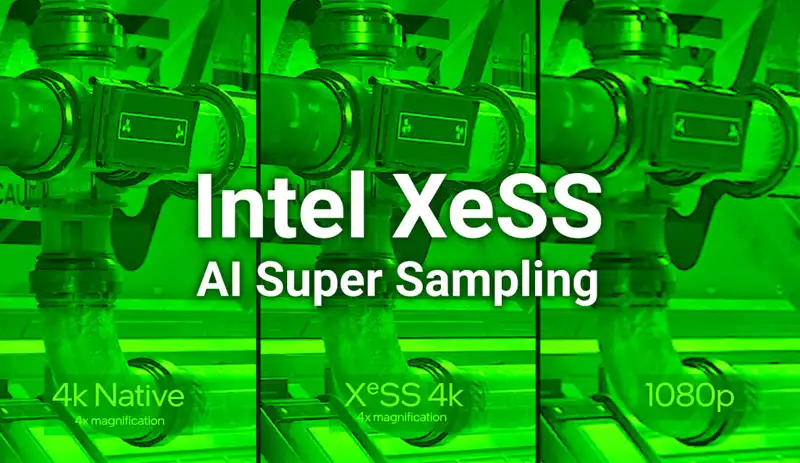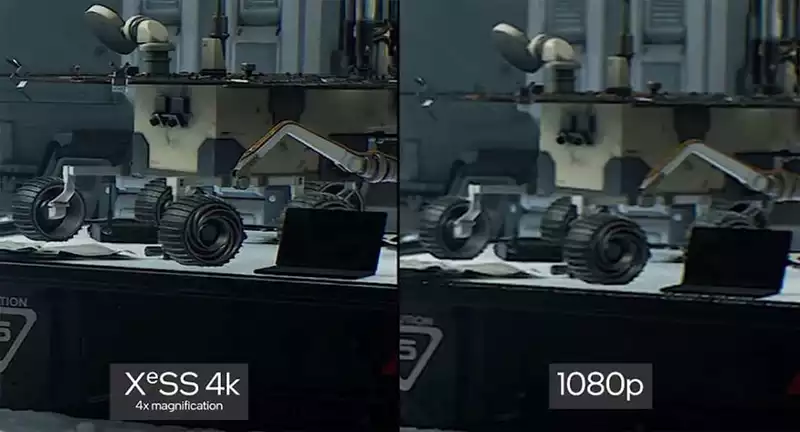You can also be interested in these:
- Intel enters the GPU game with its Xe-HPG (DG2)
- The power behind the new Intel Xe architecture
- Comparison of the Z790 and Z690 Intel motherboard chipsets
- Intel B760 vs B660 chipset: Features and differences
In our present times we have seen how artificial intelligence has taken over practically most computer processes, somehow to create more optimal algorithms based on models from previous experiences. This is also true for video game development, where processing capabilities are increasingly demanding and output rendering and display standards are more difficult to achieve, to ensure an overall performance above hardware expectations. For this reason, the Intel XeSS AI Super Sampling technology was created: To obtain more consistent results in the rendering of video games and higher rates of frames per second across the board.

Intel has been at the forefront of technology when it comes to computer components, and after its introduction to the graphics card market, it has revolutionized the field with its discoveries. The company has just launched its Intel XeSS Early Access program, geared towards video game development studios, so that they can adapt their projects currently on the market, and implement in projects on development or from scratch. This technology will be integrated into all Arc Alchemist graphics cards.
What is Intel XeSS AI Super Sampling and how does it work?
The super-resolution algorithms built into gaming GPUs have become the spearhead of the different manufacturers of these components. The titans of the graphics card industry already have technologies for these purposes, such as Nvidia’s DLSS and AMD’s FSR. Let’s say that XeSS AI Super Sampling is the name that Intel gives to its graphics enhancement technology for its GPUs.
Intel is going to offer two versions of the Intel XeSS and therefore two different algorithms. In both cases we are talking about an algorithm that is based on Deep Learning and computer vision and therefore a higher resolution image prediction system is used, with more pixels, from a lower resolution image and hence fewer pixels and more optimal processing conditions.
The first variant makes use of the “SIMD within a register” or SWAR that some GPUs have, this mechanism consists in that the 32-bit ALU can be subdivided into 2 x 16-bit ALUs performing the same instruction, or 4 x 8 bits and so on. The DP4A format consists of grouping 4 x 8-bit operands into a 32-bit register. So one of the XeSS variants will be able to run on Intel’s integrated GPUs, as well as on any GPU that supports this format, since Intel will make it open source.
The second variant of the Intel XeSS on the other hand is more complex, since it works using the Tensor units of the Intel Arc called XMX, but it doesn’t work in Nvidia GPU’s Tensor Cores. The explanation from Intel is that Nvidia keeps “top secret” the information on how the Tensor Cores and its GPUs work.
Intel XeSS AI Super Sampling is open source
The use of artificial intelligence algorithms has a caveat and that is that they depend on a large amount of data to refine and be more and more precise. This is a learning process that Intel has to go through before the release its first gaming GPUs, but this process takes time. This is why Intel has announced the Intel XeSS Early Access through its DevMesh program.
What is XeSS Early Access?
All development studios, from independent developers, freelancers, to large triple-A quality production studios can submit their game for Intel AI to learn ahead of time and have the XeSS algorithm increased precision and the ability to work with the largest number of games. possible.
Intel held a demo event on October 27, 2021 where the title Hitman III was shown, the first game to have compatibility with such technology. During the presentation, Intel made a small reveal confirming that the game will have support for Intel’s super-resolution algorithm on which they promise to deliver 4K resolutions at 1080p Full HD speeds.
How does the Intel XeSS position itself against the proposals of its competitors Nvidia and AMD?
One of the things that differentiates the XeSS from the NVIDIA DLSS is that it requires no training. In the training process we have two elements working at the same time, the first one is in charge of predicting and the second of supervising. When a prediction by the convolutional neural network is incorrect then the supervising hardware returns the negative answer, and the neural network is refined more and more until it learns to make the correct predictions.

Intel claims that with XeSS, no training is required, neither is necessary the supervision of an external system. The training is done within the GPU’s own hardware rather than on remote hardware. To do this, the GPU runs the game in two simultaneous instances at the same time, one acting as a supervisor and the other is tuning the algorithm. This allows those who implement the Intel XeSS in their games and applications not to depend on external servers.
Nvidia proposal is somewhat similar to Intel’s with its DLSS algorithm, since they have the advantage of artificial intelligence improvements accelerated by their Tensor Cores, generating a frame from a lower resolution one and thus increasing the frame rate and the performance in games.
There is another aspect in which Intel has the advantage and that is considering the temporality data, which is the information obtained from previous frames. In contrast, in AMD’s FSR, the information it processes is obtained from the current frame. Therefore, AMD technology does not need training either, because it is not based on artificial intelligence.
More stories like this
- Intel enters the GPU game with its Xe-HPG (DG2)
- The power behind the new Intel Xe architecture
- Comparison of the Z790 and Z690 Intel motherboard chipsets
- Intel B760 vs B660 chipset: Features and differences
- Which Intel CPU works best with liquid cooling?
- Intel chipsets exposed: Difference between Z690, H670, B660 and H610